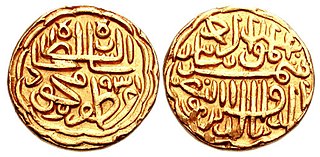Related Research Articles
Sultan Mahmud Begra or Mahmud Shah I, was the most prominent Sultan of Gujarat Sultanate. Raised to the throne at young age, he successfully captured Pavagadh and Junagadh forts in battles which gave him his name Begada. He established Champaner as the capital.

Shams-ud-Din Muzaffar Shah II or Muzafar II, born Khalil Khan, was a Sultan of the Muzaffarid dynasty, who reigned over the Gujarat Sultanate from 1511 to 1526. He was the eldest son of Sultan Mahmud Begada.

The Gujarat Sultanate, was a Medieval Indian kingdom established in the early 15th century in Western India, primarily in the present-day state of Gujarat, India. The dynasty was founded by Sultan Zafar Khan Muzaffar, identified variously as a Tanka Rajput or a Khatri, or a Jat from southern Punjab. He rose to the nobility after marriage of his sister with Firuz Shah Tughlaq, the Delhi Sultan, and would become the Governor (Naib) of Gujarat under the Delhi Sultanate. Zafar Khan defeated Farhat-ul-Mulk near Anhilwada Patan and made the city his capital. Following Timur's invasion of the Delhi Sultanate, the city was devastated and weakened considerably, so he declared himself independent from Delhi in 1407, and formally established the Sultanate of Guzerat. The next sultan, his grandson Ahmad Shah I moved the capital to Ahmedabad in 1411. His successor Muhammad Shah II subdued most Rajput chieftains. The prosperity of the sultanate reached its zenith during the rule of Mahmud Begada. He also subdued most Gujarati Rajput chieftains and built a navy off the coast of Diu. In 1509, the Portuguese empire wrested Diu from the Sultanate in the battle of Diu (1509). The Moghul emperor Humayun attacked Gujarat in 1535 and briefly occupied it, during which Bombay, Bassein& Damaon would become a Portuguese colony, thereafter Bahadur Shah was killed by the Portuguese while making a deal in 1537. The end of the sultanate came in 1573, when Akbar annexed Sultanate of Gujarat into his empire. The last ruler Muzaffar Shah III was taken a prisoner to Agra. In 1583, he escaped from the prison and with the help of the nobles succeeded to regain the throne for a short period before being defeated by Akbar's general Abdul Rahim Khan-I-Khana.
Ahmad Shah I, born Ahmad Khan, was a ruler of the Muzaffarid dynasty, who reigned over the Gujarat Sultanate from 1411 until his death in 1442.
The Sarvaiya also spelled Sarvaiyya, Sarvia, Sarwia are a Rajput clan of India, mainly found in Gujarat.
Akadia or Ankadia is a village and former Rajput petty princely state on Saurashtra peninsula.
Bajana is a village in Dasada Taluka of Surendranagar district, Gujarat, India.
Bhadvana is a village in Lakhtar Taluka of Surendranagar district, Gujarat, India. It is situated about twelve miles north east of Wadhwan station and about five miles south of Lakhtar railway station.
Chuda is a town and Taluka headquarter of Chuda Taluka in Surendranagar district, Gujarat, India. It was formerly a Rajput princely state.
Chhalala is a village in Chuda Taluka of Surendranagar district, Gujarat, India. It was formerly Rajput princely state.
Chachana is a village and former Rajput princely state in Chuda Taluka of Surendranagar district, on the Saurashtra peninsula in Gujarat, India.
Chok is a village in Jesar Taluka of Bhavnagar district, Gujarat, India. It is a former petty Rajput princely state.
Chitravav (Divani) is a village in Rajkot Taluka of Rajkot district, Gujarat, India and former petty Rajput princely state.
Bhojavadar is a village and former Rajput princely state Umrala Taluka of Bhavnagar district, Gujarat, India.
Bhoika is a village and former Rajput princely state in Limbadi Taluka of Surendranagar district, on Saurashtra in Gujarat, India.
Bhimora is a village and former Rajput-Kathi princely state in Chotila Taluka of Surendranagar district, Gujarat, India.

Muzaffar Shah I, born Zafar Khan, was a ruler of the Muzaffarid dynasty from southern Punjab, who reigned over the Gujarat Sultanate from 1391 to 1403 and later again from 1404 to 1411. Appointed as the governor of Gujarat by Tughluq of Delhi sultanate, he declared independence and founded the Gujarat Sultanate while there was chaos in Delhi following Timur's invasion. He was disposed by his ambitious son Tatar Khan but he regained shortly the throne when he died. Muzaffar Shah I was a Tank.
Nasir-ud-Din Mahmud Shah III, born Mahmud Khan was a sultan of the Muzaffarid dynasty who reigned over the Gujarat Sultanate, a late medieval kingdom in India from 1537 to 1554. He had to battle frequently with his nobles who were interested in independence, especially Darya Khán and Imád-ul-Mulk. He was killed by one of his servants.
Sikandar Shah, born Sikandar Khan, was a ruler of the Muzaffarid dynasty, who reigned over the Gujarat Sultanate for few weeks before his murder in 1526.

The tomb of Sikandar Shah, also known as Sikandar Shah Maqbara, is a mausoleum built by Gujarat Sultan Bahadur Shah in honour of his brothers and predecessors including Sikandar Shah in c. 1527 at Halol, Gujarat, India.
References
- 1 2 Gazetteer of the Bombay Presidency: Kathiawar (Public Domain text). Vol. VIII. Printed at the Government Central Press, Bombay. 1884. p. 356.
![]() This article incorporates text from a publication now in the public domain: Gazetteer of the Bombay Presidency: Kathiawar. Vol. VIII. Printed at the Government Central Press, Bombay. 1884. p. 356.
This article incorporates text from a publication now in the public domain: Gazetteer of the Bombay Presidency: Kathiawar. Vol. VIII. Printed at the Government Central Press, Bombay. 1884. p. 356.